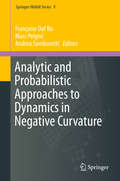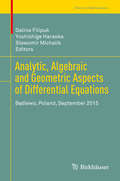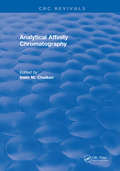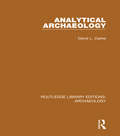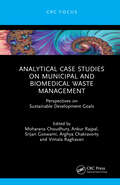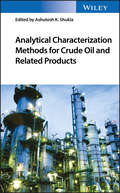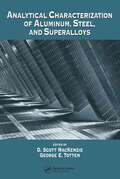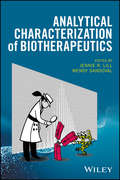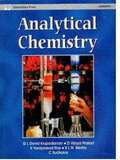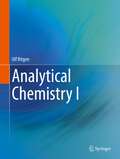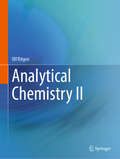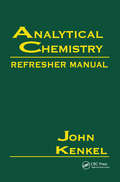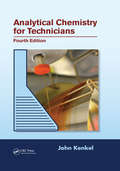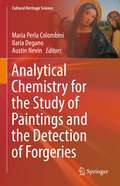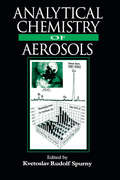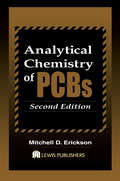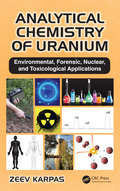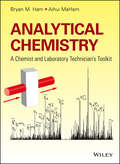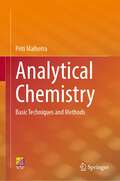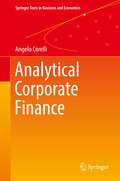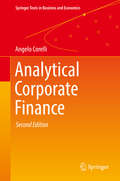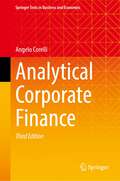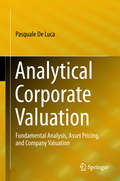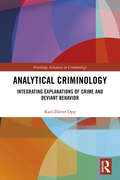- Table View
- List View
Analytic and Probabilistic Approaches to Dynamics in Negative Curvature (Springer INdAM Series #9)
by Françoise Dal'Bo Marc Peigné Andrea SambusettiThe work consists of two introductory courses, developing different points of view on the study of the asymptotic behaviour of the geodesic flow, namely: the probabilistic approach via martingales and mixing (by Stéphane Le Borgne); the semi-classical approach, by operator theory and resonances (by Frédéric Faure and Masato Tsujii). The contributions aim to give a self-contained introduction to the ideas behind the three different approaches to the investigation of hyperbolic dynamics. The first contribution focus on the convergence towards a Gaussian law of suitably normalized ergodic sums (Central Limit Theorem). The second one deals with Transfer Operators and the structure of their spectrum (Ruelle-Pollicott resonances), explaining the relation with the asymptotics of time correlation function and the periodic orbits of the dynamics.
Analytic, Algebraic and Geometric Aspects of Differential Equations: Będlewo, Poland, September 2015 (Trends in Mathematics)
by Galina Filipuk Yoshishige Haraoka Sławomir MichalikThis volume consists of invited lecture notes, survey papers and original research papers from the AAGADE school and conference held in Będlewo, Poland in September 2015. The contributions provide an overview of the current level of interaction between algebra, geometry and analysis and demonstrate the manifold aspects of the theory of ordinary and partial differential equations, while also pointing out the highly fruitful interrelations between those aspects. These interactions continue to yield new developments, not only in the theory of differential equations but also in several related areas of mathematics and physics such as differential geometry, representation theory, number theory and mathematical physics. The main goal of the volume is to introduce basic concepts, techniques, detailed and illustrative examples and theorems (in a manner suitable for non-specialists), and to present recent developments in the field, together with open problems for more advanced and experienced readers. It will be of interest to graduate students, early-career researchers and specialists in analysis, geometry, algebra and related areas, as well as anyone interested in learning new methods and techniques.
Analytical Affinity Chromatography
by Irwin M. ChaikenThis volume presents discussions of theoretical and experimental considerations that have led to the analytical affinity chromatography field, as well as current efforts to use this methodology to characterize the interaction mechanisms of biological macromolecules and to establish conditions for employing bioaffinity chromatographic systems as preparative tools. The chapters include a comprehensive discussion of interactive chromatography theory (DeLisi and Hethcote), a review of experimental data obtained for biological macromolecules and the relevant theoretical considerations of affinity chromatography which led to them (Swaisgood and Chaiken), an evaluation of rate processes in affinity chromatography and the potential to determine biologically meaningful chemical rate constants (Walters), and the use of quantitative and molecular considerations to design affinity chromatographic systems (Stellwagen and Liu).
Analytical Archaeology (Routledge Library Editions: Archaeology)
by David L. ClarkeThis study was well-established as a pioneer work on archaeological methodology, the theoretical basis of all archaeological analysis whatever the period or era. The first edition of the book presented and evaluated the radical changes in methodology which derived from developments in other disciplines, such as cybernetics, computer science and geography, during the 1950s and ‘60s. It argued that archaeology was a coherent discipline with its own methods and procedures and attempted to define the entities (attributes, artefacts, types, assemblages, cultures and culture groups) rigorously and consistently so that they could be applied to archaeological data. The later edition continued the same general theory, which is unparalleled in its scope and depth, adding notes to help understanding of the advances in method and theory to support the student and professional archaeologist. Review of the original publication: "One might venture that this is the most important archaeological work for twenty or thirty years, and it will undoubtedly influence several future generations of archaeologists." The Times Literary Supplement
Analytical Case Studies on Municipal and Biomedical Waste Management: Perspectives on Sustainable Development Goals
by Srijan Goswami Moharana Choudhury Arghya Chakravorty Ankur Rajpal Vimala RaghavanEffective waste management practices are essential to mitigate unfavourable impacts and achieve the Sustainable Development Goals. This book covers perspectives addressing the Sustainable Development Goals through analytical and case studies on municipal and biomedical waste management. It consists of ten selectively curated highly technical chapters covering various aspects of achieving the Sustainable Development Goals through applying effective waste management strategies and practices through practical case studies and examples.Features: Analysis of over 30 real-life case studies reviewed from local as well as global perspectives Discusses application of technologies in real time Addresses the 17 Sustainable Development Goals at ground level Covers a broad range of case studies on municipal solid waste and biomedical waste treatment and management Reviews the latest evidence-based approach in diagnosis and management This book is aimed at researchers and graduate students in environmental engineering and management.
Analytical Characterization Methods for Crude Oil and Related Products
by Ashutosh ShuklaBasic theory, applications, and recent trends in analytical techniques used in crude oil and related products analysis This book covers the application of different spectroscopic methods to characterize crude oil and related products. Its topics are presented in a pedagogical manner so that those new to the subject can better understand the content. The book begins by familiarizing the reader with the rheological characterization of crude oil and related products. Subsequent chapters are directed towards the current trends of different spectroscopic methods for the characterization of crude oil. Analytical Characterization Methods for Crude Oil and Related Products features chapters on: optical interrogation of petroleum asphaltenes (myths and reality); ESR characterization of organic free radicals in petroleum products; high-field, pulsed, and double resonance studies of crude oils and their derivatives; NMR spectroscopy in bitumen characterization; applications of Raman spectroscopy in crude oil and bitumen characterization; and more. Uses a bottom-up approach—starting from the basic theory of the technique followed by its applications and recent trends in crude oil analysis Includes informative content so as to take a technician to the level of using a particular analytical method Covers relevany information so as to enable a manager in the industry to make purchasing decisions Analytical Characterization Methods for Crude Oil and Related Products is aimed at researchers in academia as well as technicians and developers of new analytical methods in the oil industry and related areas. It will also be of interest to professionals, scientists, and graduate students in analytical sciences dealing with oil and environmental analysis.
Analytical Characterization of Aluminum, Steel, and Superalloys
by George E. Totten D. Scott MacKenzieAuthored by top researchers, this book discusses methodologies to quantify the properties and microstructures of aluminum, steel, and superalloys. It is a unique reference to advanced laboratory techniques in the context of characterization and property evaluation methodologies, enabling the evolution of stronger and more function-specific compositions. Topics include metallography, an atlas of microstructures, thermal analysis, x-ray diffraction, and residual stress measurement, transmission electron microscopy, electron backscattering diffraction spectroscopy, texture measurement, electron momentum spectroscopy, positron annihilation spectroscopy, and atomic probe tomography.
Analytical Characterization of Biotherapeutics
by Jennie R. Lill Wendy SandovalThe definitive guide to the myriad analytical techniques available to scientists involved in biotherapeutics research Analytical Characterization of Biotherapeutics covers all current and emerging analytical tools and techniques used for the characterization of therapeutic proteins and antigen reagents. From basic recombinant antigen and antibody characterization, to complex analyses for increasingly complex molecular designs, the book explores the history of the analysis techniques and offers valuable insights into the most important emerging analytical solutions. In addition, it frames critical questions warranting attention in the design and delivery of a therapeutic protein, exposes analytical challenges that may occur when characterizing these molecules, and presents a number of tested solutions. The first single-volume guide of its kind, Analytical Characterization of Biotherapeutics brings together contributions from scientists at the leading edge of biotherapeutics research and manufacturing. Key topics covered in-depth include the structural characterization of recombinant proteins and antibodies, antibody de novo sequencing, characterization of antibody drug conjugates, characterization of bi-specific or other hybrid molecules, characterization of manufacturing host-cell contaminant proteins, analytical tools for biologics molecular assessment, and more. Each chapter is written by a recognized expert or experts in their field who discuss current and cutting edge approaches to fully characterizing biotherapeutic proteins and antigen reagents Covers the full range of characterization strategies for large molecule based therapeutics Provides an up-to-date account of the latest approaches used for large molecule characterization Chapters cover the background needed to understand the challenges at hand, solutions to characterize these large molecules, and a summary of emerging options for analytical characterization Analytical Characterization of Biotherapeutics is an up-to-date resource for analytical scientists, biologists, and mass spectrometrists involved in the analysis of biomolecules, as well as scientists employed in the pharmaceuticals and biotechnology industries. Graduate students in biology and analytical science, and their instructors will find it to be fascinating and instructive supplementary reading.
Analytical Chemistry
by D. Vijaya Prasad K. Varaprasad Rao C. Sudhakar K. L. N. Reddy G. L. David KrupadanamOne of the most important aspects of chemistry is the isolation, purification and quantitative analysis of compounds. Chromatography is one of the most extensively used techniques in the research and industrial analytical chemistry laboratories for the purification, identification and quantification of organic, inorganic and biomolecules. The book is meant for the chemistry students of B.Sc. and those working in research and analytical laboratories in drug, pesticide and other chemical industries.
Analytical Chemistry I
by Ulf RitgenThis workbook takes you through the successful work Harris, Textbook of Quantitative Analysis and is designed primarily for self-study. In five parts, the lecture content of analytical chemistry is summarized and explained using selected examples. Basic concepts of analytical chemistry are presented as well as the principle and various techniques of dimensional analysis and chromatography. UV/VIS, infrared and Raman spectroscopy are used to explain the investigation of molecularly present compounds, and selected techniques of atomic spectroscopy conclude the introduction to the fundamentals of analysis. The textbook's essential sections and illustrations are repeatedly referred to, which facilitates independent learning of the fundamentals of analytical chemistry.Easy to read, the book introduces the fundamentals and key techniques of analytical chemistry; it is aimed at undergraduate students of chemistry or related science subjects. It repeatedly refers back to the basics familiar from courses in general chemistry, so that the connections between what is already known and what is new become immediately apparent. Learning with this workbook has been tested in a distance learning chemistry course and facilitates preparation for module examinations in analytical chemistry.This book is a translation of the original German 1st edition Analytische Chemie I by Ulf Ritgen, published by Springer-Verlag GmbH Germany, part of Springer Nature in 2019. The translation was done with the help of artificial intelligence (machine translation by the service DeepL.com). A subsequent human revision was done primarily in terms of content, so that the book will read stylistically differently from a conventional translation. Springer Nature works continuously to further the development of tools for the production of books and on the related technologies to support the authors.
Analytical Chemistry II
by Ulf RitgenThis workbook takes you through the successful textbook Skoog/Holler/Crouch, Instrumentelle Analytik and is designed primarily for self-study.In five parts, the lecture content of more advanced analytical chemistry is summarized and explained using selected examples: mass spectrometry and nuclear magnetic resonance spectroscopy deal with the investigation of molecules, and numerous electroanalytical methods such as potentiometry, coulometry, amperometry and voltammetry are also covered. An overview of more specialized analytical methods includes the use of radioactive substances and various fluorescence methods, as well as methods of information acquisition in the increasingly important electrochemical and optical sensor technology and their automation. The course concludes with a summary of various principles and application methods of statistics, which are simply indispensable in the context of analytics. In order to facilitate independent learning, references to essential sections and illustrations of the textbook are made throughout the book.Not least because of the numerous examples, the book, which is aimed at students of chemistry or related scientific subjects, provides an easy-to-understand introduction to more complex aspects of analytical chemistry. In direct continuation of the workbook Analytical Chemistry I, references are made again and again to already known basics from other courses, which facilitate the linking of the familiar and the new. Learning with this workbook has been tested in a distance learning chemistry course and facilitates preparation for module examinations in more advanced analytical chemistry.This book is a translation of the original German 1st edition Analytische Chemie II by Ulf Ritgen, published by Springer-Verlag GmbH Germany, part of Springer Nature in 2020. The translation was done with the help of artificial intelligence (machine translation by the service DeepL.com). A subsequent human revision was done primarily in terms of content, so that the book will read stylistically differently from a conventional translation. Springer Nature works continuously to further the development of tools for the production of books and on the related technologies to support the authors.
Analytical Chemistry Refresher Manual
by John KenkelAnalytical Chemistry Refresher Manual provides a comprehensive refresher in techniques and methodology of modern analytical chemistry. Topics include sampling and sample preparation, solution preparation, and discussions of wet and instrumental methods of analysis; spectrometric techniques of UV, vis, and IR spectroscopy; NMR, mass spectrometry, and atomic spectrometry techniques; analytical separations, including liquid-liquid extraction, liquid-solid extraction, instrumental and non-instrumental chromatography, and electrophoresis; and basic theory and instrument design concepts of gas chromatography and high-performance liquid chromatography. The manual also covers automation, potentiometric and voltammetric techniques, and the detection and accounting of laboratory errors. Analytical Chemistry Refresher Manual will benefit all laboratory workers, water and wastewater professionals, and academic researchers who are looking for a readable reference covering the fundamentals of modern analytical chemistry.
Analytical Chemistry for Technicians
by John KenkelWritten as a training manual for chemistry-based laboratory technicians, this thoroughly updated fourth edition of the bestselling Analytical Chemistry for Technicians emphasizes the applied aspects rather than the theoretical ones. The book begins with classical quantitative analysis and follows with a practical approach to the complex world of so
Analytical Chemistry for the Study of Paintings and the Detection of Forgeries (Cultural Heritage Science)
by Austin Nevin Maria Perla Colombini Ilaria DeganoForgeries present a daunting problem to art historians, museums, galleries and curators who face challenges in determining the authenticity of paintings. Recent progress in science has led to the development of new methods for investigating works of art, and can provide new insights into the materials found in paintings. The rise in the value of paintings together with the knowledge and skills of forgers highlights the need to develop reliable scientific procedures to identify fakes. Given the complexity of materials in paintings and the convergence of various disciplines, a methodological approach for nvestigations of paintings is based on art historical, curatorial, aesthetic, technical and scientific evaluation. In this book sophisticated digital and analytical techniques are reviewed for the identification of materials (pigments, binders, varnishes, adhesives) and the physical characteristics of paintings such as brushstrokes, craquelure and canvas weaves. This book presents an updated overview of both non-invasive and micro-invasive techniques that enable the material characterization of paintings. The materials constituting a painting are reviewed, as are ways that changes in materials over time can provide insights into chronology and physical history. State-of the art digital metods including multi and hyper-spectral imaging and computational approaches to data treatment will be presented. Analytical techniques developed and optimized to characterize binders, varnishes, and pigments are reviewed, focusing on materials which can provide information on ageing or provenance. Case studies of applications of synchrotron-based methods and the analysis of paintings are given, as are chapters devoted to legal aspects related to authenticity. Chapter 1 is available open access under a Creative Commons Attribution 4.0 International License via link.springer.com.
Analytical Chemistry of Aerosols: Science and Technology
by Kvetoslav Rudolf SpurnyUntil the 1980s, researchers studied and measured only the physical properties of aerosols. Since the 80s, however, interest in the physicochemcal properties of aerosols has grown tremendously. Scientists in environmental hygiene, medicine, and toxicology have recognized the importance held by the chemical composition and properties of aerosols and the interactions of inhaled, "bad" aerosols.This book offers the first comprehensive treatment of modern aerosol analytical methods, sampling and separation procedures, and environmental applications, and offers critical reviews of the latest literature. This important field has developed rapidly in the last 15 years, but until now, no book effectively summarized or analyzed the existing research.Analytical Chemistry of Aerosols reviews procedures, techniques, and trends in the measurement and analysis of atmospheric aerosols. With contributions from acknowledged, international experts, the book discusses various methods of bulk analysis, single particle analysis, and the analysis of special aerosol systems, including fibrous and bacterial aerosols.
Analytical Chemistry of PCBs
by Mitchell D. EricksonThis updated and expanded Second Edition of Dr. Erickson's Analytical Chemistry of PCBs appears a decade after the first and is completely revised and updated. The changes from the First Edition reflect the significant growth in the area and a growing appreciation of the importance of PCB analysis to our culture. This book is a comprehensive review of the analytical chemistry of PCBs. It is part history, part annotated bibliography, part comparison, and part guidance. Featuring a new chapter on analyst/customer interactions and several new appendices, the Second Edition is an invaluable resource for both chemists with no experience in PCB analysis and seasoned PCB researchers. All topics have been more thoroughly treated and updated in this new edition to reflect advances made in the last decade, especially:
Analytical Chemistry of Uranium: Environmental, Forensic, Nuclear, and Toxicological Applications
by Zeev KarpasAccurate uranium analysis, and particularly for isotope measurements, is essential in many fields, including environmental studies, geology, hydrogeology, the nuclear industry, health physics, and homeland security. This volume covers the fascinating advances in the field of analytical chemistry of uranium. Exploring a broad range of topics, the book focuses on industrial processes that involve uranium, its presence in the environment, health and biological implications of exposure to uranium compounds, and nuclear forensics. Each chapter includes an overview of the topic and several examples to demonstrate the analytical procedures. Separation and purification techniques are included where necessary.
Analytical Chemistry: A Chemist and Laboratory Technician's Toolkit
by Bryan M. Ham Aihui MahamA comprehensive study of analytical chemistry providing the basics of analytical chemistry and introductions to the laboratory Covers the basics of a chemistry lab including lab safety, glassware, and common instrumentation Covers fundamentals of analytical techniques such as wet chemistry, instrumental analyses, spectroscopy, chromatography, FTIR, NMR, XRF, XRD, HPLC, GC-MS, Capillary Electrophoresis, and proteomics Includes ChemTech an interactive program that contains lesson exercises, useful calculators and an interactive periodic table Details Laboratory Information Management System a program used to log in samples, input data, search samples, approve samples, and print reports and certificates of analysis nteractive periodic table, and a copy of all of the chapters of the book that can be opened and read on a computer or other electronic devices.
Analytical Chemistry: Basic Techniques and Methods
by Priti MalhotraThis book is designed as an undergraduate textbook for students of analytical chemistry. It can also be used as a reference book to study analytical methods in chemical analysis that have wide applications in various areas such as life sciences, clinical chemistry, air and water pollution, and industrial analysis. It covers fundamentals of analytical chemistry and the various analytical methods and techniques. This textbook includes pedagogical features such as worked examples and unsolved problems at the end of each chapter. This book is also useful for students of life sciences, clinical chemistry, air and water pollution, and industrial analysis.
Analytical Commentary to the UNCITRAL Arbitration Rules
by Peter BinderThis title concentrates on the legislative background of the UNCITRAL arbitration rules 2010, its easy-to-follow, article-by-article approach makes referencing easy.
Analytical Corporate Finance (Springer Texts in Business and Economics)
by Angelo CorelliThis book draws readers' attention to the financial aspects of daily life at a corporation by combining a robust mathematical setting and the explanation and derivation of the most popular models of the firm. Intended for third-year undergraduate students of business finance, quantitative finance, and financial mathematics, as well as first-year postgraduate students, it is based on the twin pillars of theory and analytics, which merge in a way that makes it easy for students to understand the exact meaning of the concepts and their representation and applicability in real-world contexts. Examples are given throughout the chapters in order to clarify the most intricate aspects; where needed, there are appendices at the end of chapters, offering additional mathematical insights into specific topics. Due to the recent growth in knowledge demand in the private sector, practitioners can also profit from the book as a bridge-builder between university and industry. Lastly, the book provides useful information for managers who want to deepen their understanding of risk management and come to recognize what may have been lacking in their own systems.
Analytical Corporate Finance (Springer Texts in Business and Economics)
by Angelo CorelliThis book draws readers’ attention to the financial aspects of daily life at a corporation by combining a robust mathematical setting and the explanation and derivation of the most popular models of the firm. Intended for third-year undergraduate students of business finance, quantitative finance, and financial mathematics, as well as first-year postgraduate students, it is based on the twin pillars of theory and analytics, which merge in a way that makes it easy for students to understand the exact meaning of the concepts and their representation and applicability in real-world contexts. Examples are given throughout the chapters in order to clarify the most intricate aspects; where needed, there are appendices at the end of chapters, offering additional mathematical insights into specific topics. Due to the recent growth in knowledge demand in the private sector, practitioners can also profit from the book as a bridge-builder between university and industry. Lastly, the book provides useful information for managers who want to deepen their understanding of risk management and come to recognize what may have been lacking in their own systems.
Analytical Corporate Finance (Springer Texts in Business and Economics)
by Angelo CorelliThis book draws readers’ attention to the financial aspects of daily life at a corporation by combining a robust mathematical setting and the explanation and derivation of the most popular models of the firm. Intended for third-year undergraduate students of business finance, quantitative finance, and financial mathematics, as well as first-year postgraduate students, it is based on the twin pillars of theory and analytics, which merge in a way that makes it easy for students to understand the exact meaning of the concepts and their representation and applicability in real-world contexts. Examples are given throughout the chapters in order to clarify the most intricate aspects; where needed, there are appendices at the end of chapters, offering additional mathematical insights into specific topics. Due to the recent growth in knowledge demand in the private sector, practitioners can also profit from the book as a bridge-builder between university and industry. Lastly, the book provides useful information for managers who want to deepen their understanding of risk management and come to recognize what may have been lacking in their own systems.
Analytical Corporate Valuation: Fundamental Analysis, Asset Pricing, And Company Valuation
by Pasquale De LucaThis book integrates the models employed in the fundamental analysis of a company with the models used by investors in the capital markets to diversify risks and maximize expected returns. The underlying thesis is that the company creates value only if the return on capital invested exceeds the cost of capital, while the objective is to demonstrate how integration of the fields of corporate finance and asset pricing enables comprehensive and accurate company valuation. Companies can thrive only if they are able to create value for shareholders over time. A company’s value creation and the correct approach to its measurement require two main skills: first, the ability to analyze and evaluate the company’s fundamentals with respect to its business model and its performance over time; and second, knowledge of investors’ models with regard to risk diversification and return maximization from which the cost of capital for the firm is derived. Based on this perspective, the book combines rigorous quantitative analysis with effective use of graphics to aid intuitive understanding.
Analytical Criminology: Integrating Explanations of Crime and Deviant Behavior (Routledge Advances in Criminology)
by Karl-Dieter OppThere are more than 20 theories that explain crime. Each theory has weaknesses, and no scholar knows which theory is best. To remedy this unsatisfactory situation a new research program of comparative theory testing is proposed. Comparing the theories with each other has not yet been successful. The alternative, suggested in this book, is to show how criminological theories must be modified if they are compared with a general behavioral theory. The book shows under which conditions the major criminological theories provide valid explanations of crime. The latter thus become integrated as parts of the general theory. The general theory that is chosen is a version of the theory of rational action. This is not the problematic version discussed in the literature, but states the real conditions of decision making and, thus, explains when people actually violate the law or remain law-abiding. The general theory is a component of a theoretical approach that explains individual behavior in interaction with societal (macro) conditions. This micro-macro approach is summarized in a proposed structural-cognitive model. This is part of the new program of Analytical Criminology. It suggests empirical theory comparison, process explanations, and micro-macro explanations. The book is not only written for readers who are interested in theories of crime and deviant behavior. It is also a treatise in "analytical" (i.e., rigorous) theory construction and empirical theory comparison.
